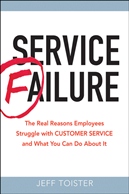Five Ways to Avoid Self-sabotage in Customer Service
 Jeff Toister
Jeff Toister  Monday, January 24, 2011 at 7:48AM |
Monday, January 24, 2011 at 7:48AM |  Customer service can be difficult enough without any extra 'help', but service providers often unknowingly self-sabotage their efforts. Here are five ways you can avoid hurting your own customer service.
Customer service can be difficult enough without any extra 'help', but service providers often unknowingly self-sabotage their efforts. Here are five ways you can avoid hurting your own customer service.
Tip #1: Avoid trigger words
Have you ever wondered why telling an irate person to "Calm down" has the opposite effect? There are certain words that can trigger a customer's anger in emotional situations. For example, the word "No" can trigger an outburst because it makes a customer feel powerless and without options. A saavy customer service rep will find other ways to deliver the message without igniting anger, even if the answer really is "No". See some more examples.
Tip #2: Avoid quoting time in ranges
We often need to give a customer a time frame for something to happen. For instance, we might say, "Your replacement part will arrive in 2 - 4 business days." Unfortunately, it's human nature for your customer to only hear "2 days". Your customer may get upset when the promised part doesn't arrive two days later. It's much better to give one date, such as "Your replacement part will arrive by Friday, January 28." If it arrives early, you are a superstar. If it arrives by the 28th, you simply made good on your promise.
Tip #3: Set conservative expectations
Anytime you get a chance to set expectations, set them low so they are easier to exceed! For example, let's say you need 30 minutes to research a question and get back to your customer with an answer. If you say 30 minutes, you are risking a service problem if something interrupts you and it takes 45 minutes to respond. On the other hand, if the customer agrees to a one hour response time and you get back to them in 45 minutes, your response time seems faster than expected!
Tip #4: Follow-up on problems
A great way to avoid looking like a slug is to follow-up on problems to make sure everything is OK. For example, let's say you agree to help a customer with a billing problem. You contact someone in your accounting department and ask them to make the adjustment and send out a corrected statement. You'll score a few points with your customer if you follow-up to make sure the problem has been resolved. You may also sniff out a problem before it gets worse if you discover they still haven't gotten what they needed.
Tip #5: Listen fully and without judgment
Complete this sentence. "When listening to a customer, it's always wise to avoid jumping to ___________." I bet the word "conclusions" flashed into your brain, right? Most of the time, the ability to fill in the blanks is a terrific skill to have. Unfortunately, it's a habit that can be dangerous when we are listening to a customer's needs, especially if we don't fill in the blank correctly. For example, the word that should complete the sentence above is "solutions", a small but subtle difference!
How else can we avoid self-sabotage in customer service? Leave your tips in the comments section below!






